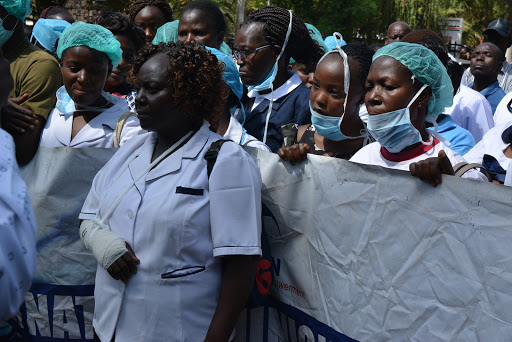 Nurses protesting their remuneration levels in Kenya in the past.
Nurses protesting their remuneration levels in Kenya in the past.
The world’s nursing workforce is growing but deep and persistent inequities threaten to undermine global health goals on Universal Health Coverage.
According
to the newly released State of the World’s Nursing 2025 report (SoWN), while
the number of nurses worldwide has risen to nearly 30 million.
The report warns that stark disparities in distribution, education and working conditions are leaving millions without the care they need-and putting the achievement of universal health coverage (UHC) and the Sustainable Development Goals (SDGs) at risk.
The latest figures from the World Health Organization (WHO), in collaboration with the International Council of Nurses (ICN) and global partners, show that the global nursing workforce has expanded from 27.9 million in 2018 to 29.8 million in 2023. This growth reflects significant efforts by many countries to address critical shortages and strengthen their health systems.
The WHO said in a statement that there is also progress in closing the gap. The estimated global shortage of nurses has dropped from 6.2 million in 2020 to 5.8 million in 2023. If current trends continue, projections suggest the shortfall could fall further to 4.1 million by 2030.
“This report contains encouraging news, for which we congratulate the countries that are making progress,” said Dr Tedros Adhanom Ghebreyesus, WHO Director-General, in the statement. “However, we cannot ignore the inequalities that mark the global nursing landscape. On International Nurses Day, I urge countries and partners to use this report as a signpost, showing us where we’ve come from, where we are now, and where we need to go as rapidly as possible.”
Despite these gains, the report reveals a world divided. An overwhelming 78 per cent of the world’s nurses are concentrated in countries that account for just 49 per cent of the global population. This means that more than half of the world’s people must rely on just over a fifth of the global nursing workforce.
The consequences of these disparities are severe. It has made millions, especially in rural and underserved areas lack access to qualified nurses and essential health services.
The report states, “Persistent and worsening inequities within nursing including in the distribution of nurses, nurse education, wages, working conditions and nurse shortages. This inequity trend recurs among and within regions, across countries and within countries, and by country income classification. The impacts of the inequities affect patient care and health outcomes, health system functioning, health equity and access and economic and social development.”
Further, the report highlights on the disparities between high- and low-income countries. High-income countries enjoy a dense concentration of nurses, robust educational systems, and greater resources for employment and retention. However, they face their own looming crisis: an aging workforce and high rates of retirement threaten future supply. In these countries, 23% of nurses are foreign-born, reflecting a heavy reliance on international recruitment.
By contrast, low- and middle-income countries (LMICs) struggle to graduate, employ and retain enough nurses to meet their populations’ needs. Chronic underinvestment, limited educational capacity and poor working conditions drive persistent shortages. In upper middle-income countries, just 8% of nurses are foreign-born, falling to 1% in lower middle-income and 3% in low-income countries.
“Low- and middle-income countries are
facing challenges in graduating, employing and retaining nurses in their health
systems and will need to raise domestic investments to create and sustain jobs.
Contrastingly, high-income countries need to be prepared to manage high levels
of retiring nurses and review their reliance on foreign-trained nurses,” the
report emphasizes.
International migration is a double-edged
sword for the global nursing workforce. While it offers opportunities for
individual nurses and can help fill gaps in high-income countries, it often creates
shortages in the countries that can least afford to lose their health
professionals.
Globally, one in seven nurses is foreign-born. The report calls for strengthened bilateral agreements and ethical recruitment practices to ensure that international migration does not undermine health systems in source countries.
Pam Cipriano, President of the International Council of Nurses said, “We welcome the SoWN 2025 report as an important milestone for monitoring progress on strengthening and supporting the nursing workforce towards global health goals. The report clearly exposes the inequalities that are holding back the nursing profession and acting as a barrier to achieving universal health coverage (UHC). Delivering on UHC is dependent on truly recognizing the value of nurses and on harnessing the power and influence of nurses to act as catalysts of positive change in our health systems.”
On the part of gender, the report confirms
that nursing remains a predominantly female profession, with women constituting
85% of the global workforce. While this is a testament to women’s leadership in
health, it also highlights persistent gender inequities, including wage gaps,
underrepresentation in senior roles, and exposure to workplace discrimination
and violence.
The report notes that advancing gender equity in nursing is not only a matter of justice but also a strategic imperative for strengthening health systems and achieving global health goals.
The Human Cost of Inequity has
far-reaching consequences. These are: Millions of people, particularly in rural
and underserved areas, lack access to qualified nurses and essential health
services; Shortages and maldistribution of nurses contribute to higher rates of
preventable illness and death, increased health system strain, and reduced
resilience in the face of emergencies; Chronic understaffing drives up costs
through inefficiency, burnout and turnover, while also undermining economic
development and the achievement of the SDGs.










